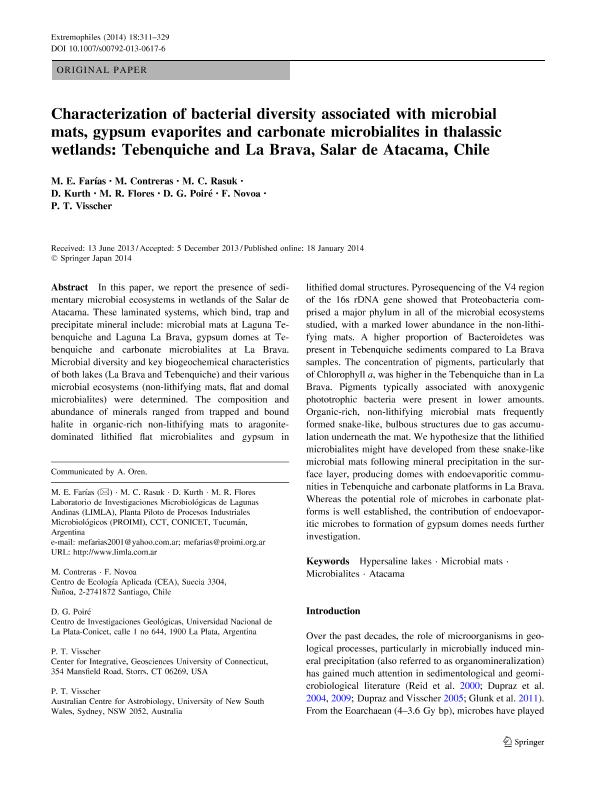Mostrar el registro sencillo del ítem
dc.contributor.author
Farias, Maria Eugenia

dc.contributor.author
Contreras, M.
dc.contributor.author
Rasuk, Maria Cecilia

dc.contributor.author
Kurth, Daniel German

dc.contributor.author
Flores, María Regina

dc.contributor.author
Poire, Daniel Gustavo

dc.contributor.author
Novoa, F.
dc.contributor.author
Visscher, P. T.
dc.date.available
2017-11-13T17:59:11Z
dc.date.issued
2014-03
dc.identifier.citation
Farias, Maria Eugenia; Contreras, M.; Rasuk, Maria Cecilia; Kurth, Daniel German; Flores, María Regina; et al.; Characterization of bacterial diversity associated with microbial mats, gypsum evaporites and carbonate microbialites in thalassic wetlands: Tebenquiche and La Brava, Salar de Atacama, Chile; Springer Tokyo; Extremophiles; 18; 2; 3-2014; 311-329
dc.identifier.issn
1431-0651
dc.identifier.uri
http://hdl.handle.net/11336/28032
dc.description.abstract
In this paper, we report the presence of sedimentary microbial ecosystems in wetlands of the Salar de Atacama. These laminated systems, which bind, trap and precipitate mineral include: microbial mats at Laguna Tebenquiche and Laguna La Brava, gypsum domes at Tebenquiche and carbonate microbialites at La Brava. Microbial diversity and key biogeochemical characteristics of both lakes (La Brava and Tebenquiche) and their various microbial ecosystems (non-lithifying mats, flat and domal microbialites) were determined. The composition and abundance of minerals ranged from trapped and bound halite in organic-rich non-lithifying mats to aragonite-dominated lithified flat microbialites and gypsum in lithified domal structures. Pyrosequencing of the V4 region of the 16s rDNA gene showed that Proteobacteria comprised a major phylum in all of the microbial ecosystems studied, with a marked lower abundance in the non-lithifying mats. A higher proportion of Bacteroidetes was present in Tebenquiche sediments compared to La Brava samples. The concentration of pigments, particularly that of Chlorophyll a, was higher in the Tebenquiche than in La Brava. Pigments typically associated with anoxygenic phototrophic bacteria were present in lower amounts. Organic-rich, non-lithifying microbial mats frequently formed snake-like, bulbous structures due to gas accumulation underneath the mat. We hypothesize that the lithified microbialites might have developed from these snake-like microbial mats following mineral precipitation in the surface layer, producing domes with endoevaporitic communities in Tebenquiche and carbonate platforms in La Brava. Whereas the potential role of microbes in carbonate platforms is well established, the contribution of endoevaporitic microbes to formation of gypsum domes needs further investigation.
dc.format
application/pdf
dc.language.iso
eng
dc.publisher
Springer Tokyo

dc.rights
info:eu-repo/semantics/openAccess
dc.rights.uri
https://creativecommons.org/licenses/by-nc-sa/2.5/ar/
dc.subject
Hypersaline Lakes
dc.subject
Microbial Mats
dc.subject
Microbialites
dc.subject
Atacama
dc.subject.classification
Meteorología y Ciencias Atmosféricas

dc.subject.classification
Ciencias de la Tierra y relacionadas con el Medio Ambiente

dc.subject.classification
CIENCIAS NATURALES Y EXACTAS

dc.title
Characterization of bacterial diversity associated with microbial mats, gypsum evaporites and carbonate microbialites in thalassic wetlands: Tebenquiche and La Brava, Salar de Atacama, Chile
dc.type
info:eu-repo/semantics/article
dc.type
info:ar-repo/semantics/artículo
dc.type
info:eu-repo/semantics/publishedVersion
dc.date.updated
2017-10-31T17:51:07Z
dc.journal.volume
18
dc.journal.number
2
dc.journal.pagination
311-329
dc.journal.pais
Japón

dc.journal.ciudad
Tokyo
dc.description.fil
Fil: Farias, Maria Eugenia. Consejo Nacional de Investigaciones Científicas y Técnicas. Centro Científico Tecnológico Conicet - Tucuman. Planta Piloto de Procesos Industriales Microbiologicos; Argentina
dc.description.fil
Fil: Contreras, M.. Centro de Ecología Aplicada; Chile
dc.description.fil
Fil: Rasuk, Maria Cecilia. Consejo Nacional de Investigaciones Científicas y Técnicas. Centro Científico Tecnológico Conicet - Tucuman. Planta Piloto de Procesos Industriales Microbiologicos; Argentina
dc.description.fil
Fil: Kurth, Daniel German. Consejo Nacional de Investigaciones Científicas y Técnicas. Centro Científico Tecnológico Conicet - Tucuman. Planta Piloto de Procesos Industriales Microbiologicos; Argentina
dc.description.fil
Fil: Flores, María Regina. Consejo Nacional de Investigaciones Científicas y Técnicas. Centro Científico Tecnológico Conicet - Tucuman. Planta Piloto de Procesos Industriales Microbiologicos; Argentina
dc.description.fil
Fil: Poire, Daniel Gustavo. Consejo Nacional de Investigaciones Científicas y Técnicas. Centro Científico Tecnológico Conicet - La Plata. Centro de Investigaciones Geológicas. Universidad Nacional de La Plata. Facultad de Ciencias Naturales y Museo. Centro de Investigaciones Geológicas; Argentina
dc.description.fil
Fil: Novoa, F.. Centro de Ecologia Aplicada; Chile
dc.description.fil
Fil: Visscher, P. T.. Center For Integrative Geosciences; Estados Unidos
dc.journal.title
Extremophiles

dc.relation.alternativeid
info:eu-repo/semantics/altIdentifier/url/http://link.springer.com/article/10.1007/s00792-013-0617-6
dc.relation.alternativeid
info:eu-repo/semantics/altIdentifier/doi/http://dx.doi.org/10.1007/s00792-013-0617-6
Archivos asociados
